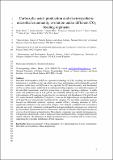| dc.contributor.author | Dessì, Paolo | |
| dc.contributor.author | Sánchez, Carlos | |
| dc.contributor.author | Mills, Simon | |
| dc.contributor.author | Cocco, Francesco Giuseppe | |
| dc.contributor.author | Isipato, Marco | |
| dc.contributor.author | Ijaz, Umer Z. | |
| dc.contributor.author | Collins, Gavin | |
| dc.contributor.author | Lens, Piet N.L. | |
| dc.date.accessioned | 2021-01-18T09:44:58Z | |
| dc.date.available | 2021-01-18T09:44:58Z | |
| dc.date.issued | 2020-10-15 | |
| dc.identifier.citation | Dessì, Paolo, Sánchez, Carlos, Mills, Simon, Cocco, Francesco Giuseppe, Isipato, Marco, Ijaz, Umer Z., Collins, Gavin, Lens, Piet N. L. (2021). Carboxylic acids production and electrosynthetic microbial community evolution under different CO2 feeding regimens. Bioelectrochemistry, 137, 107686. doi:https://doi.org/10.1016/j.bioelechem.2020.107686 | en_IE |
| dc.identifier.issn | 1567-5394 | |
| dc.identifier.uri | http://hdl.handle.net/10379/16456 | |
| dc.description.abstract | Microbial electrosynthesis (MES) is a potential technology for CO2 recycling, but insufficient information is available on the microbial interactions underpinning electrochemically-assisted reactions. In this study, a MES reactor was operated for 225 days alternately with bicarbonate or CO2 as carbon source, under batch or continuous feeding regimens, to evaluate the response of the microbial communities, and their productivity, to dynamic operating conditions. A stable acetic acid production rate of 9.68 g m-2 d-1, and coulombic efficiency up to 40%, was achieved with continuous CO2 sparging, higher than the rates obtained with bicarbonate (0.94 g m-2 d-1) and CO2 under fed-batch conditions (2.54 g m-2 d-1). However, the highest butyric acid production rate (0.39 g m-2 d-1) was achieved with intermittent CO2 sparging. The microbial community analyses focused on differential amplicon sequence variants (ASVs), allowing detection of ASVs significantly different across consecutive samples. This analysis, combined with co-occurence network analysis, and cyclic voltammetry, indicated that hydrogen-mediated acetogenesis was carried out by Clostridium, Eubacterium and Acetobacterium, whereas Oscillibacter and Caproiciproducens were involved in butyric acid production. The cathodic community was spatially inhomogeneous, with potential electrotrophs, such as Sulfurospirillum and Desulfovibrio, most prevalent near the current collector. The abundance of Sulfurospirillum positively correlated with that of Acetobacterium, supporting the syntrophic metabolism of both organisms. | en_IE |
| dc.description.sponsorship | This publication was supported by the Science Foundation of Ireland (SFI) Research Professorship Programme on Innovative Energy Technologies for Bioenergy, Biofuels and a Sustainable Irish Bioeconomy (IETSBIO3, award 15/RP/2763) and the Research Infrastructure grant Platform for Biofuel Analysis (Award no. 16/RI/3401). MI gratefully acknowledges the Sardinian Regional Government for the financial support of his PhD scholarship (P.O.R. Sardegna F.S.E. - Operational Programme of the Autonomous Region of Sardinia, European Social Fund 2014-2020 - Axis III Education and training, Thematic goal 10, Investment Priority 10ii), specific goal 10.5. UZI is supported by a NERC Independent Research Fellowship (NE/L011956/1). GC and SM were supported by a European Research Council Starting Grant (3C-BIOTECH 261330). GC is supported by the SFI Career Development Award programme (award no. 17/CDA/4658). The authors acknowledge the facilities, and scientific and technical assistance of the Centre for Microscopy & Imaging at the National University of Ireland Galway (www.imaging.nuigalway.ie). | en_IE |
| dc.format | application/pdf | en_IE |
| dc.language.iso | en | en_IE |
| dc.publisher | Elsevier | en_IE |
| dc.relation.ispartof | Bioelectrochemistry | en |
| dc.rights | Attribution-NonCommercial-NoDerivs 3.0 Ireland | |
| dc.rights.uri | https://creativecommons.org/licenses/by-nc-nd/3.0/ie/ | |
| dc.subject | Bioelectrochemistry | en_IE |
| dc.subject | Chain elongation | en_IE |
| dc.subject | CO2 electroreduction | en_IE |
| dc.subject | Cyclic voltammetry | en_IE |
| dc.subject | Microbial electrosynthesis | en_IE |
| dc.subject | Miseq sequencing | en_IE |
| dc.title | Carboxylic acids production and electrosynthetic microbial community evolution under different CO2 feeding regimes | en_IE |
| dc.type | Article | en_IE |
| dc.date.updated | 2021-01-14T15:39:03Z | |
| dc.identifier.doi | 10.1016/j.bioelechem.2020.107686 | |
| dc.local.publishedsource | https://doi.org/10.1016/j.bioelechem.2020.107686 | en_IE |
| dc.description.peer-reviewed | peer-reviewed | |
| dc.contributor.funder | Science Foundation Ireland | en_IE |
| dc.contributor.funder | Sardinian Regional Government | en_IE |
| dc.internal.rssid | 24366370 | |
| dc.local.contact | Paolo Dessi. Email: paolo.dessi@nuigalway.ie | |
| dc.local.copyrightchecked | Yes | |
| dc.local.version | ACCEPTED | |
| nui.item.downloads | 142 | |


